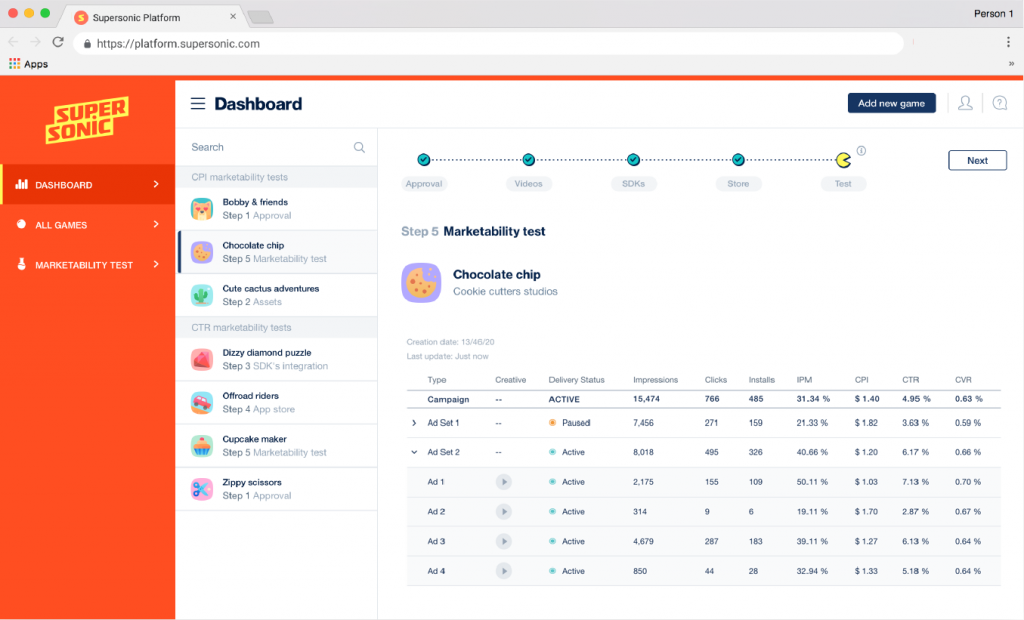How to do market research for your app
As the market becomes increasingly saturated, apps can no longer rely on organic installs to gain users - strong user acquisition is a must to survive such fierce competition. This is particularly important for hyper-casual games, and in order to acquire users at scale, developers need to have a game with a strong product-market fit. There is a difference between a good game and a marketable game - developers need to make sure that they have both. That is why before global launch, or even full development, it is a must to test the marketability of a game or concept.
Now with Supersonic’s self-serve platform, developers can easily test the marketability of their games. Here are a few tips for testing on it. To access the platform, tap 'submit your game' in the top right corner of this page.
Marketability testing: What should the ad look like?
Marketability testing for hyper-casual games involves launching a campaign to a limited, untargeted audience and analyzing its performance. The key areas to look at are the conversion from impression to install, and the CPI (cost per install) in order to understand the appeal and marketability of the gameplay.
Building the right video is important - the video needs to be clear, to represent the gameplay well, and to hook the player in the first couple of seconds. At Supersonic, we usually test multiple different video ad creatives simultaneously, which helps us analyze the gameplay’s marketability and not a specific video’s performance.
What you should be measuring
There are two different strategies for testing the marketability of a game or game concept: testing for CTR (click-through rate) and testing for CPI. While we support both, we usually recommend sticking to the CPI test. That’s because CTR doesn’t always correlate to the low CPI we want later on: we’ve seen several marketability tests where a developer achieves a high CTR for a video ad creative, and then when they launch a CPI test, the CPI is far higher than anticipated.

Cost per install (CPI)
With this in mind, your first marketability test should be measured according to CPI, which means you need to build a game and publish it on the app stores. Because statistically there is a high chance the game will not have a strong enough market appeal, save time by only developing an MVP (minimal viable product). Build only a few levels of the game - enough to be able to create a variety of video ads to test - and don’t worry about metrics like retention and play time. At this early stage, these are not the priority - CPI is. If the CPI is promising after the initial test, then you can begin to design the game in more detail and account for retention and playtime.
CPI determines how much you will pay the ad source (such as Facebook) for each install your game generates from the ad campaign. Because hyper-casual users have relatively lower LTV, economies of scale is crucial to make significant profit from hyper-casual games. Paying a high CPI for users that have low ARPU and LTV means you will lose money and your hyper-casual game will not be sustainable.
In hyper-casual, gameplay is the most influential factor in CPI. Other factors such as art, camera perspective, and colors have a limited impact, and won't be able to significantly reduce CPI. For instance, if your CPI is over $1, it will be very challenging to reduce it to the $0.30 mark - which is an important benchmark for a hyper-casual hit - by optimizing these elements. In this instance, you should cut your losses and move on to a new concept.
Click-through rate (CTR)
Although we recommend CPI for marketability testing, we still support CTR for developers who prefer this approach. It is better suited to developers who don’t yet have an MVP published on the app stores, and only have a concept which has been built into a video ad.
CTR is calculated by dividing the number of clicks an ad receives by the number of times an ad was shown, and then multiplying by 100. For example, if a mobile ad has 15 clicks and 1,000 ad impressions, its click through rate would be 1.5% - meaning 1.5% of users clicked on the mobile ad and were redirected to the landing page.
A good CTR for hyper-casual ad creatives when testing marketability is more than 4%: if your ad creative exceeds this number, it's a sign you’re onto something and potentially there is a good product-market fit. In this case, you can proceed to build your minimal viable product (MVP). If your results are below this benchmark, it’s best to move on to a different idea. Remember, the hyper-casual market is all about failing fast and testing frequently.
Ad creative optimization
If your initial marketability test has produced promising results, then the Supersonic team will start building new creatives for your game that seek to optimize their performance ahead of global launch.
This involves experimenting with the gameplay, text, call to action, duration, and difficulty level of different variations, and A/B testing to find out what performs best. Another way to optimize ad creatives is tapping into gamer motivations. We know from experience that hyper-casual gamers like a challenge, so we often recommend editing the video ad to play on this motivation, such as by adding text like “Bet you’ll fail this”, or by increasing the difficulty level.
A key point to remember is that the first three seconds of the ad creative are the most important: you need to instantly hook users and ensure the ad creative is immediately intuitive. That means, for instance, avoiding on-screen instructions, which tend to decrease engagement. If instructions are needed for your hyper-casual ad creative, then it means you’ve not made the gameplay intuitive enough.
A money saving tool
Ultimately, marketability testing is a way to reduce uncertainty and let data help you make the right decisions for your new game. Whether you just have a prototype, or your game is published and you’re eager to launch it globally, running these tests will show you how the market will react to your game, and could potentially save you from spending time and money on a concept that’s likely to fail. In the hyper-competitive hyper-casual world, not getting too attached to your game ideas and reacting swiftly to the data can be make or break for your business.
To access the platform, tap 'submit your game' in the top right corner of this page.
Learn more by checking out our other blogs, including ‘Our Guide To Mobile Game Publishers’, ‘5 Tips For A Profitable Hyper Casual Game Launch’, and ‘4 Tips To Get The Attention Of A Mobile Game Publisher’
Let's put these tips to good use
Publish your game with Supersonic



